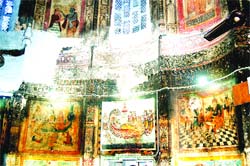 The following is an abstract of a paper which deals with effect of going to temples on children. Really interesting
The following is an abstract of a paper which deals with effect of going to temples on children. Really interestingTemple Ecology and Cognitive Development: A Report from South India
R. Muralidharan
Department of Educational Psychology, National Council of Educational Research and Training, New Delhi, India
Ashok K. Srivastava
Department of Psychology, National Council of Educational Research and Training, New Delhi, India
The impact of growing up in the vicinity of Hindu temples on cognitive development was studied in the southern part of India. Enrolled in Grades 1 and 4, the participating children (N-281) were drawn from three kinds of ecology, i.e., families intimately associated with temple, families that are religious but not so intimately associated with temple, and families in non-temple areas, using a cross-sectional design. NCERT School Readiness Scale and Das-Naglieri Cognitive Assessment System were used to assess their cognitive development. Children associated with temples emerged to be more cognitively competent than other two groups of children on both points of schooling. Sex differences and their interaction with ecology were not significant for most of the measures. Results point to the role of temple institutions in shaping development of children byproviding rich and variegated ecology.












